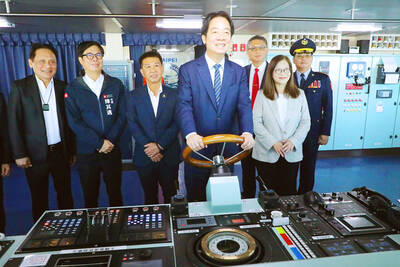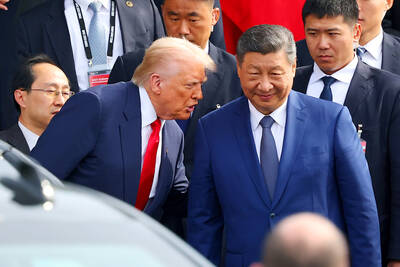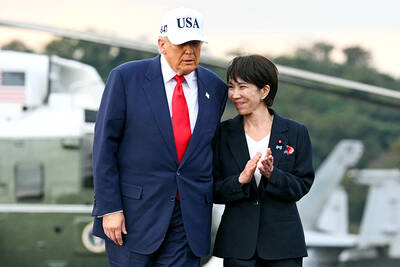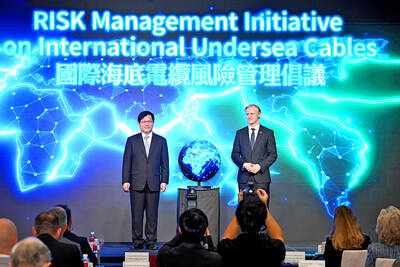There is a deafening, unearthly howl as if a jumbo jet was firing up its engines in London's Albert Hall. On the screen in the control room a ghostly pinkish glow whips round the edges of the inside of the nuclear reactor. At its core it is 10 times hotter than the center of the sun.
This, according to some physicists, is the solution to the energy crisis -- a future with cheap, reliable, safe and nearly waste-free power. Today, after years of false starts and political wrangling dating from the Cold War, they will get their chance to make that dream a reality. A 10 billion euro (US$12.74 billion) project, called Iter, to build a prototype nuclear fusion reactor will be signed off in Brussels by the EU, Japan, China, South Korea, India and the US.
The prospect of virtually limitless energy is not merely science fiction. The haunting, screaming growl of matter being smashed together at unimaginably high speed is a daily occurrence at Jet in Oxfordshire, an existing experimental fusion reactor. Jet is by far the biggest of the world's 28 fusion reactors. It is the work of scientists here that has paved the way for the much bigger Iter, which, once the project is ratified in December, will be built in Cadarache in southern France.
Its advocates say nuclear fusion is the most promising long-term solution to the energy crisis, offering the possibility of abundant power from cheap fuel with no greenhouse gases and low levels of radioactive waste. But critics say the UK government is gambling huge sums of money -- 44 percent of it's research and development budget for energy -- on a long shot with no guarantee of ever producing useful energy.
Last week British Prime Minister Tony Blair backed conventional nuclear power, saying in a speech to business leaders that not replacing Britain's aging nuclear power stations would be "a serious dereliction of our duty to the future of this country."
He argued that only nuclear energy could prevent a huge hike in CO2 emissions once the current nuclear stations were decommissioned.
But while the debate over the future of conventional nuclear power continues, many physicists argue that fusion is the future.
"Fusion works -- it powers the sun and stars," said Sir Chris Llewellyn Smith, head of the UK Atomic Energy Authority. "In the second part of the century I'm optimistic it will indeed be a major part of the world energy portfolio."
Unlike nuclear fission, which tears atomic nuclei apart to release energy, fusion involves squeezing the nuclei of two hydrogen atoms together. This process releases a helium nucleus and a neutron plus huge quantities of energy. The hydrogen fuel is part heavy hydrogen or deuterium, which can be easily extracted from water, and part super-heavy hydrogen or tritium, which can be made from lithium, a reasonably abundant metal.
The energy produced is truly colossal. The lithium in just one laptop battery and the heavy hydrogen from half a bath of water could provide enough energy for the average European for 30 years.
One of fusion's big advantages over fission is safety. Firstly, there is no chance of a runaway meltdown as happened at Chernobyl. If you stop applying the fuel or switch off the magnetic jacket that keeps the fuel in the reactor, the reaction just stops.
"It is very difficult to keep it running. It is like keeping honey on the back of a spoon," said Mathias Brix, a physicist at Jet.
Also, the quantities of fuel involved are much smaller than in fission reactors. Jet contains less than a gram of fuel, while Chernobyl had 250 tonnes. Lastly, the fuel and waste from the reactor is much less radioactive. But although physicists think they understand fusion, harnessing it has proved extremely difficult.
Research first began in the 1950s with claims that fusion would provide reliable power by the end of the century but even now scientists admit that a commercial application is at least 40 years away. The problem is getting two nuclei close enough to fuse and then controlling the reaction. This means putting in huge amounts of energy at the start to convert less than a gram of the fusion fuel into a super-hot gas or plasma. Hydrogen nuclei flying around at high speed in the plasma can then come close enough together to fuse.
In 1991 Jet was the first fusion reactor to do this using a mixture of deuterium and tritium. It proved that fusion reactors could work, but was not a viable energy option because it only pumped out about 70 percent of the energy required to start the process off.
"The purpose of these experiments is not really to produce energy but to learn how to control the hot gas," Smith said.
Iter will be 10 times the volume of Jet and produce 10 times the energy needed to get the reaction started.
"It's the step where we will demonstrate scientifically and technically that fusion energy is a viable energy source," said Akko Mass, one of the Iter scientists.
But with so many broken promises some involved in the project doubt it will yield commercial energy any time soon. Iter scientist John How described the billed 40-year timescale as "very, very, very ambitious." He suspects it will be nearer to a century.

CALL FOR SUPPORT: President William Lai called on lawmakers across party lines to ensure the livelihood of Taiwanese and that national security is protected President William Lai (賴清德) yesterday called for bipartisan support for Taiwan’s investment in self-defense capabilities at the christening and launch of two coast guard vessels at CSBC Corp, Taiwan’s (台灣國際造船) shipyard in Kaohsiung. The Taipei (台北) is the fourth and final ship of the Chiayi-class offshore patrol vessels, and the Siraya (西拉雅) is the Coast Guard Administration’s (CGA) first-ever ocean patrol vessel, the government said. The Taipei is the fourth and final ship of the Chiayi-class offshore patrol vessels with a displacement of about 4,000 tonnes, Lai said. This ship class was ordered as a result of former president Tsai Ing-wen’s (蔡英文) 2018

UKRAINE, NVIDIA: The US leader said the subject of Russia’s war had come up ‘very strongly,’ while Jenson Huang was hoping that the conversation was good Chinese President Xi Jinping (習近平) and US President Donald Trump had differing takes following their meeting in Busan, South Korea, yesterday. Xi said that the two sides should complete follow-up work as soon as possible to deliver tangible results that would provide “peace of mind” to China, the US and the rest of the world, while Trump hailed the “great success” of the talks. The two discussed trade, including a deal to reduce tariffs slapped on China for its role in the fentanyl trade, as well as cooperation in ending the war in Ukraine, among other issues, but they did not mention

Japanese Prime Minister Sanae Takaichi yesterday lavished US President Donald Trump with praise and vows of a “golden age” of ties on his visit to Tokyo, before inking a deal with Washington aimed at securing critical minerals. Takaichi — Japan’s first female prime minister — pulled out all the stops for Trump in her opening test on the international stage and even announced that she would nominate him for a Nobel Peace Prize, the White House said. Trump has become increasingly focused on the Nobel since his return to power in January and claims to have ended several conflicts around the world,

GLOBAL PROJECT: Underseas cables ‘are the nervous system of democratic connectivity,’ which is under stress, Member of the European Parliament Rihards Kols said The government yesterday launched an initiative to promote global cooperation on improved security of undersea cables, following reported disruptions of such cables near Taiwan and around the world. The Management Initiative on International Undersea Cables aims to “bring together stakeholders, align standards, promote best practices and turn shared concerns into beneficial cooperation,” Minister of Foreign Affairs Lin Chia-lung (林佳龍) said at a seminar in Taipei. The project would be known as “RISK,” an acronym for risk mitigation, information sharing, systemic reform and knowledge building, he said at the seminar, titled “Taiwan-Europe Subsea Cable Security Cooperation Forum.” Taiwan sits at a vital junction on